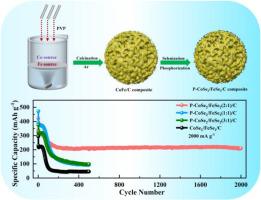p掺杂CoSe2/FeSe2异质结纳米颗粒锚定在泡沫状碳骨架上作为超快稳定的钠离子存储阳极
IF 3.9
2区 材料科学
Q2 MATERIALS SCIENCE, MULTIDISCIPLINARY
引用次数: 0
摘要
采用直接热解-吹扫+磷酸化/硒化工艺合成了锚定在三维多孔泡沫状碳网络上的p掺杂CoSe2/FeSe2异质结纳米颗粒(2-10 nm)。这种碳网络作为电子传导的连续途径,提高了比表面积,减轻了循环过程中电极体积的膨胀。具体来说,p掺杂进一步提高了CoSe2/FeSe2纳米颗粒的导电性,显著加快了电化学动力学,并在高电流密度下实现了高比容量。得益于独特的纳米结构和原子级p掺杂,P-CoSe2/FeSe2(2:1)/C阳极具有突出的循环稳定性(在2000 mA g - 1下循环2000次后为210.9 mAh g - 1)和卓越的倍率能力(在5000 mA g - 1下为323.5 mAh g - 1)。本研究表明,将异质结工程与杂原子掺杂相结合是提高钠离子电池阳极长期循环稳定性的有效策略。本文章由计算机程序翻译,如有差异,请以英文原文为准。

P-doped CoSe2/FeSe2 heterojunction nanoparticles anchored on foam-like carbon skeleton as an ultrafast and stable sodium-ion storage anode
P-doped CoSe2/FeSe2 heterojunction nanoparticles (2–10 nm) anchored on a three-dimensional porous foam-like carbon network were synthesized via a direct pyrolysis-blowing strategy followed by phosphorization/selenization process. This carbon network serves as a continuous pathway for electron conduction, enhances specific surface area, and alleviates electrode volume expansion during cycling. Specifically, P-doping further improves the electrical conductivity of CoSe2/FeSe2 nanoparticles, significantly accelerating electrochemical kinetics and enabling high specific capacities at elevated current densities. Benefiting from the unique nanostructure and atomic-level P-doping, the P-CoSe2/FeSe2(2:1)/C anode delivers prominent cycling stability (210.9 mAh g−1 after 2000 cycles at 2000 mA g−1) and exceptional rate capability (323.5 mAh g−1 at 5000 mA g−1). This work demonstrates that combining heterojunction engineering with heteroatom doping is an effective strategy to enhance the long-term cycling stability of sodium-ion battery anodes.
求助全文
通过发布文献求助,成功后即可免费获取论文全文。
去求助
来源期刊

Vacuum
工程技术-材料科学:综合
CiteScore
6.80
自引率
17.50%
发文量
0
审稿时长
34 days
期刊介绍:
Vacuum is an international rapid publications journal with a focus on short communication. All papers are peer-reviewed, with the review process for short communication geared towards very fast turnaround times. The journal also published full research papers, thematic issues and selected papers from leading conferences.
A report in Vacuum should represent a major advance in an area that involves a controlled environment at pressures of one atmosphere or below.
The scope of the journal includes:
1. Vacuum; original developments in vacuum pumping and instrumentation, vacuum measurement, vacuum gas dynamics, gas-surface interactions, surface treatment for UHV applications and low outgassing, vacuum melting, sintering, and vacuum metrology. Technology and solutions for large-scale facilities (e.g., particle accelerators and fusion devices). New instrumentation ( e.g., detectors and electron microscopes).
2. Plasma science; advances in PVD, CVD, plasma-assisted CVD, ion sources, deposition processes and analysis.
3. Surface science; surface engineering, surface chemistry, surface analysis, crystal growth, ion-surface interactions and etching, nanometer-scale processing, surface modification.
4. Materials science; novel functional or structural materials. Metals, ceramics, and polymers. Experiments, simulations, and modelling for understanding structure-property relationships. Thin films and coatings. Nanostructures and ion implantation.
 求助内容:
求助内容: 应助结果提醒方式:
应助结果提醒方式:


